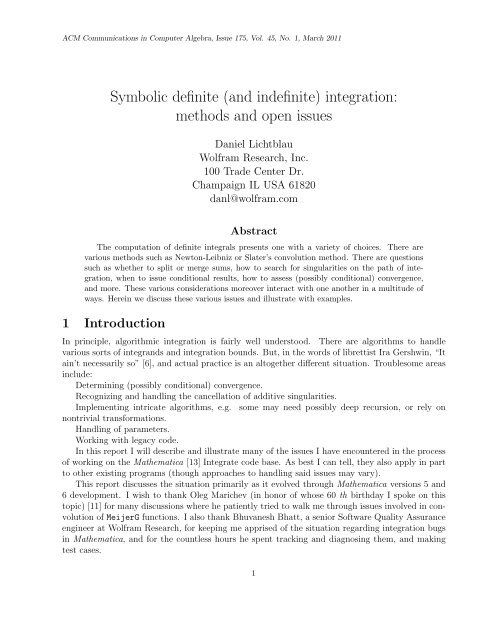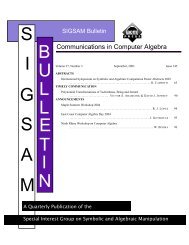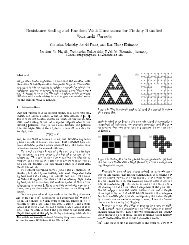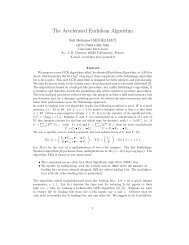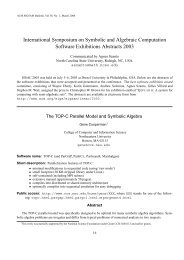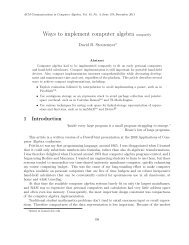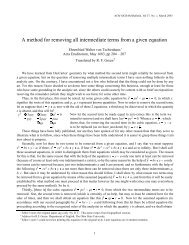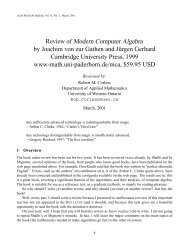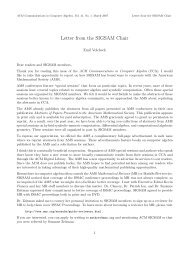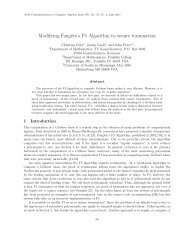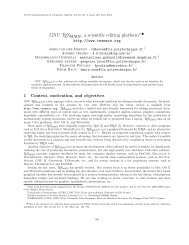Symbolic definite (and indefinite) integration: methods ... - SIGSAM
Symbolic definite (and indefinite) integration: methods ... - SIGSAM
Symbolic definite (and indefinite) integration: methods ... - SIGSAM
You also want an ePaper? Increase the reach of your titles
YUMPU automatically turns print PDFs into web optimized ePapers that Google loves.
ACM Communications in Computer Algebra, Issue 175, Vol. 45, No. 1, March 2011<br />
<strong>Symbolic</strong> <strong>definite</strong> (<strong>and</strong> in<strong>definite</strong>) <strong>integration</strong>:<br />
<strong>methods</strong> <strong>and</strong> open issues<br />
Daniel Lichtblau<br />
Wolfram Research, Inc.<br />
100 Trade Center Dr.<br />
Champaign IL USA 61820<br />
danl@wolfram.com<br />
Abstract<br />
The computation of <strong>definite</strong> integrals presents one with a variety of choices. There are<br />
various <strong>methods</strong> such as Newton-Leibniz or Slater’s convolution method. There are questions<br />
such as whether to split or merge sums, how to search for singularities on the path of <strong>integration</strong>,<br />
when to issue conditional results, how to assess (possibly conditional) convergence,<br />
<strong>and</strong> more. These various considerations moreover interact with one another in a multitude of<br />
ways. Herein we discuss these various issues <strong>and</strong> illustrate with examples.<br />
1 Introduction<br />
In principle, algorithmic <strong>integration</strong> is fairly well understood. There are algorithms to h<strong>and</strong>le<br />
various sorts of integr<strong>and</strong>s <strong>and</strong> <strong>integration</strong> bounds. But, in the words of librettist Ira Gershwin, “It<br />
ain’t necessarily so” [6], <strong>and</strong> actual practice is an altogether different situation. Troublesome areas<br />
include:<br />
Determining (possibly conditional) convergence.<br />
Recognizing <strong>and</strong> h<strong>and</strong>ling the cancellation of additive singularities.<br />
Implementing intricate algorithms, e.g. some may need possibly deep recursion, or rely on<br />
nontrivial transformations.<br />
H<strong>and</strong>ling of parameters.<br />
Working with legacy code.<br />
In this report I will describe <strong>and</strong> illustrate many of the issues I have encountered in the process<br />
of working on the Mathematica [13] Integrate code base. As best I can tell, they also apply in part<br />
to other existing programs (though approaches to h<strong>and</strong>ling said issues may vary).<br />
This report discusses the situation primarily as it evolved through Mathematica versions 5 <strong>and</strong><br />
6 development. I wish to thank Oleg Marichev (in honor of whose 60 th birthday I spoke on this<br />
topic) [11] for many discussions where he patiently tried to walk me through issues involved in convolution<br />
of MeijerG functions. I also thank Bhuvanesh Bhatt, a senior Software Quality Assurance<br />
engineer at Wolfram Research, for keeping me apprised of the situation regarding <strong>integration</strong> bugs<br />
in Mathematica, <strong>and</strong> for the countless hours he spent tracking <strong>and</strong> diagnosing them, <strong>and</strong> making<br />
test cases.<br />
1
<strong>Symbolic</strong> <strong>integration</strong>: <strong>methods</strong> <strong>and</strong> open issues<br />
While we focus on particulars of Mathematica h<strong>and</strong>ling, I would be remiss in not pointing out<br />
that there is other work on this topic, some of which takes very different approaches to similar<br />
issues. In particular, see Davenport’s synopsis of this same topic [4], <strong>and</strong> various articles authored<br />
or coauthored by Jeffrey on removal of path singularities [7, 8, 9]. I also thank David Jeffrey <strong>and</strong><br />
an anonymous referee for numerous helpful comments <strong>and</strong> for pointing out several mistakes in an<br />
earlier draft.<br />
2 Basic Structure of Integrate Code in Mathematica<br />
2.1 In<strong>definite</strong> Integration<br />
The in<strong>definite</strong> <strong>integration</strong> code consists primarily of a partial implementation of the Risch algorithm<br />
[2, 5], in addition to extensive table lookup <strong>methods</strong>. The former h<strong>and</strong>les the elementary integral<br />
cases that do not involve algebraic extensions, <strong>and</strong> a few simple extension cases of low degree. The<br />
latter tackles integr<strong>and</strong>s with exponentials, trigonometrics <strong>and</strong>/or hyperbolics, elliptic integrals,<br />
<strong>and</strong> integr<strong>and</strong>s involving special functions, particularly after the Risch <strong>methods</strong> have given up. The<br />
actual situation is slightly more complicated in that Risch code may h<strong>and</strong>le part of an integr<strong>and</strong>,<br />
sending the rest to table lookup code. That in turn may do transformations <strong>and</strong> call back the<br />
integrate code recursively. The Mathematica implementation resorts to the Risch code early on,<br />
followed by extensive table code for h<strong>and</strong>ling of special functions as well as elementary function<br />
integr<strong>and</strong>s that this implementation of Risch fails to integrate.<br />
In addition to what is stated above, some integr<strong>and</strong> transformations are attempted prior to all<br />
else. The idea here is to recognize cases where one integr<strong>and</strong> may be converted to something that<br />
is easier to work with, but equivalent modulo a multiplicative constant (for example, transforming<br />
√<br />
x2 to x<br />
( √x<br />
2<br />
x<br />
)<br />
, <strong>and</strong> treating the second factor as a differential constant).<br />
Also useful are mathematically equivalent transformations such as factorization <strong>and</strong> partial<br />
fractions decomposition. An added wrinkle is that such transformations can invert one another,<br />
<strong>and</strong> it is often difficult to recognize which one will be beneficial to a given integr<strong>and</strong>. Thus one<br />
must take care to avoid attempting them blindly, <strong>and</strong>, in so doing, incurring the infinite wrath of<br />
the gods of recursion. In the Mathematica code base an attempt is made to determine, in various<br />
places, whether a transformation of the above type might be useful, <strong>and</strong> to apply it if so. It should<br />
be emphasized that this is, at best, a heuristic process (<strong>and</strong> at worse, a VERY recursive one...)<br />
Last we mention that there is no intrinsic reason to split into integr<strong>and</strong>s h<strong>and</strong>led by Risch vs.<br />
those that are not. Another approach might be to use table lookup (e.g. via pattern matching) as<br />
a first step, followed by a Risch implementation, followed by further lookup. In order for this to be<br />
useful the first lookup would need to be fast (that is, would need to fail quickly when it will fail at<br />
all). A table-based approach that might be useful for this first step is described [10, 12].<br />
2.2 Definite Integration<br />
Definite <strong>integration</strong> is done via a number of <strong>methods</strong> as indicated below.<br />
Special case contour <strong>integration</strong>.<br />
Newton-Leibniz code (in brief: compute an in<strong>definite</strong> integral, then evaluate it at endpoints<br />
<strong>and</strong> perhaps in limits at path singularities). There are various places where Mathematica will use<br />
this approach. The first such is specialized for integr<strong>and</strong>s of the form rational × trig or rational ×<br />
exponential.<br />
2
Lichtblau<br />
Newton-Leibniz code specialized for integr<strong>and</strong>s containing logs <strong>and</strong>/or polylogs. This code is<br />
more complicated than for the previously described case.<br />
A general case implementation of Newton-Leibniz <strong>integration</strong>. Still more complicated code.<br />
An implementation of <strong>definite</strong> <strong>integration</strong> by convolution of MeijerG functions [1]. This requires<br />
that we integrate from 0 to infinity. It also requires that the integr<strong>and</strong> be represented as a power<br />
of the <strong>integration</strong> variable times one or two MeijerG functions. Since a UnitStep function may be<br />
represented as a MeijerG, we may waive the semi-infinite range requirement whenever the integr<strong>and</strong><br />
otherwise requires but one MeijerG. This method in particular uses several transformation tactics<br />
to h<strong>and</strong>le algebraics, trigs, logs, exponentials, <strong>and</strong> so forth. Hence it has its own tree of specialized<br />
code subsets.<br />
The overall implementation is best described as a polyalgorithm that calls on any or all of the<br />
above in various ways, depending on heuristics (or perhaps the mood of the little man inside the<br />
code).<br />
2.3 Brief Descriptions <strong>and</strong> Examples of the Two Primary Methods of<br />
Definite Integration<br />
2.3.1 Newton-Leibniz<br />
First we find an antiderivative to the integr<strong>and</strong>. We then try to assess from the <strong>integration</strong> path<br />
whether there are c<strong>and</strong>idate points of discontinuity for integr<strong>and</strong> or antiderivative (e.g. due to<br />
branch cuts), or places where the integr<strong>and</strong> may spike to infinity. These we collectively refer to as<br />
path singularities. We treat each point in one of two ways (based on crude heuristics): either issue<br />
a proviso on parameters that guarantee the point is not a “bad” point, or else split the <strong>integration</strong><br />
path at that point <strong>and</strong> use limits as we approach from either side. Once the <strong>integration</strong> path is<br />
split into suitable segments we take appropriate limits of the antiderivative as we approach the<br />
segment endpoints from appropriate directions, then sum these signed values to get the resulting<br />
<strong>definite</strong> integral. In cases where we have infinite spikes, we attempt to determine whether they are<br />
individually integrable.<br />
Here is a classical example that incorrectly gave zero in a prior version of Mathematica. We<br />
integrate 1/x around a closed contour enclosing the origin. The syntax below indicates we are to<br />
use a segment-by-segment traversal, where segments connect the given path points. Note that one<br />
path, from −1 + i to −1 − i, must be split where it crosses the (negative) real axis. This is due<br />
to the fact that the antiderivative is the logarithm function, <strong>and</strong> Mathematica uses the canonical<br />
choice of placing the branch cut along the negative real axis. (As a referee pointed out, a path<br />
split for a branch cut crossing must happen somewhere, since we integrate around a loop <strong>and</strong> would<br />
obtain zero without such a split.)<br />
Integrate[1/z, {z, 1 + I, −1 + I, −1 − I, 1 − I, 1 + I}]<br />
2iπ<br />
2.3.2 Slater Convolution via MeijerG Products<br />
The idea in this case is to make suitable transformations so that we have an integr<strong>and</strong> in f(z) is<br />
expressed as a product of the form z k MeijerG [expression 1 ] MeijerG [expression 2 ] where we integrate<br />
from 0 to infinity. While this path may seem rather specialized, bear in mind that translations<br />
<strong>and</strong> rotations can move a path to the real axis, <strong>and</strong> we can represent UnitStep as a MeijerG<br />
3
<strong>Symbolic</strong> <strong>integration</strong>: <strong>methods</strong> <strong>and</strong> open issues<br />
(<br />
function. (Specifically, for x > −2 we have θ(x) = G 0,1<br />
1,1 x + 1<br />
∣ 1 )<br />
) This means we can treat a<br />
0<br />
finite interval on the positive axis as though it were semi-infinite, at the cost of a MeijerG factor.<br />
The basic convolution theorem is discussed in [1].<br />
Several common functions such as trigs, various exponentials, Bessel functions, <strong>and</strong> certain<br />
common algebraics e.g. (a + bx n ) m may be represented as MeijerG functions, while others may be<br />
brought to MeijerG form after some suitable transformation of variables. Hence we look for viable<br />
transformations <strong>and</strong> then do a table driven conversion in an effort to obtain the desired form.<br />
Once in the factored form above (or perhaps a simpler form wherein any factor or factors are<br />
not present) we go into convolution code, at the heart of which lies a function that formulates<br />
the integrated result as a new MeijerG expression via the Slater theorem. It then performs some<br />
manipulations in an effort to recast in terms of better known functions.<br />
Here is a simple example.<br />
val = Integrate [BesselJ[2, x]x 2 e −x+2 , {x, 0, ∞}]<br />
3e 2<br />
4 √ 2<br />
This operated by first converting the integr<strong>and</strong> [ to an “inert” form representing ] the integr<strong>and</strong><br />
product as x 2 MeijerG[{{}, {}}, {{0}, {}}, x]MeijerG {{}, {}}, {{1}, {−1}}, x2<br />
4<br />
3 Software Engineering Problems Associated with this<br />
Body (Corpus? Corpse?) of Integration Code<br />
Below are several of the issues that confronted me in the process of fixing bugs in Mathematica’s<br />
symbolic <strong>integration</strong>. I suspect many are found in any general purpose symbolic <strong>integration</strong> code<br />
base.<br />
Different modules, written by different people, were often not on the best of speaking terms.<br />
Hence various pieces of functionality of potentially general use were reinvented. In some cases<br />
this had bad consequences beyond code bloat, such as inconsistencies of bugs, different unstated<br />
underlying assumptions, <strong>and</strong> so on.<br />
Much was legacy code, written over a period of about 15 years, by several different people. It<br />
remains spread over several dozen source code files (which is good, to the extent that it improves<br />
modularity). No one person ever understood all of it, <strong>and</strong> some parts are no doubt to this day not<br />
understood by anyone−−this is one of the pitfalls of legacy code. I find it unlikely that, in an area<br />
of this scope, a significant body of code will be entirely understood by the team that develops it.<br />
Some of the steps used are quite fragile. Specifically they may be sensitive to small changes in<br />
seemingly unrelated functions such as Together (providing a “canonical” form to rational functions),<br />
Apart (a partial fractions decomposition, which has some ill-defined behaviors tied to needs of<br />
Integrate), Factor, Solve, Simplify, <strong>and</strong> others. After encountering this problem in many forms<br />
I have come to conclude that it really is endemic to symbolic <strong>integration</strong> <strong>and</strong> not simply an artifact<br />
of implementation details. The entire idea of working with transformations of integr<strong>and</strong>s, coupled<br />
with the mathematical impossibility of creating canonical forms for all possible expressions, <strong>and</strong> the<br />
difficulty of forcing transformations to be improvements for a given purpose, make this a thorny<br />
issue. Indeed, certain types of st<strong>and</strong>ard tactics such as <strong>integration</strong> by parts or use of l’Hospital’s<br />
rule for limit extraction can actually lead to infinite recursion if not done with considerable caution.<br />
4
Lichtblau<br />
There are tradeoffs to be made between speed <strong>and</strong> power. One wants to try certain transformations,<br />
for example, in order to h<strong>and</strong>le certain classes of problem. But there is no plausible<br />
way in general to delimit cases that may hang in the transformation process. Hence some form of<br />
delimiting is required e.g. by time or operation count.<br />
Many classes of <strong>integration</strong> problem can make use of assumptions regarding, say, behavior of<br />
the integr<strong>and</strong> at infinity. Some parts of the legacy code were not everywhere cognizant of such<br />
assumptions, <strong>and</strong> may have made contradictory ones (which, not surprisingly, was a cause of may<br />
bug reports). And even when code appropriately tries to determine e.g. behavior at infinity via<br />
given assumptions, there is the issue noted above, where, say, limit extraction may hang if not<br />
suitably constrained. But when constraints on time, memory, or some measure of operation count<br />
are used, how is one to h<strong>and</strong>le an aborted intermediate result? With a warning message? By giving<br />
up? By continuing as though it had been a “good” case e.g. of convergence at infinity?<br />
<strong>Symbolic</strong> <strong>integration</strong> is one of the most complicated pieces of machinery to be found in algorithmic<br />
mathematics. The reliance on other functions as well as intricacies of exploring possible<br />
integr<strong>and</strong> transformation certainly implies that it will have a nontrivial implementation. Hence it<br />
is vital that the pieces be adequately documented. This is a rule throughout the field of software<br />
development, but the importance cannot be overstated in the context of mathematical <strong>integration</strong><br />
(it is of course important for code <strong>integration</strong> as well).<br />
When I began work on this body of code, more than one out of every four open bugs in the<br />
Mathematica kernel (with around 2000 functions) was in the category of <strong>definite</strong> <strong>integration</strong> (a part<br />
of one function, Integrate). This mass posed several problems in <strong>and</strong> of itself. First, the function<br />
clearly receives widespread usage, <strong>and</strong> hence it is difficult to start from scratch. Second, the scope<br />
made it a bit difficult to perform adequate triage (that is to say, it is hard to see the forest for<br />
the trees). Third, the massive overhaul needed strongly implied that there would be considerable<br />
breakage, at least in the short term. Fourth is the likelihood that the scope of trouble exceeds the<br />
capabilities of any one developer—<strong>and</strong> I can attest that it certainly exceeds the capabilities of this<br />
particular developer.<br />
4 Issues in the Implementation of In<strong>definite</strong> Integration<br />
We will discuss in brief some issues that tend to be specific to in<strong>definite</strong> <strong>integration</strong>. As our primary<br />
focus is on <strong>definite</strong> <strong>integration</strong> we defer to the next section those that are common to both.<br />
4.1 The Curse of Recursing<br />
Often an integral may be broken into two parts. I (facetiously) claim that the technical term for<br />
the first part is “done” while that for the second is “not done”. The second term might be further<br />
rewritten in ways that return one to the original problem or a variant thereof, thus leading to<br />
recursive splitting. As an example of an integr<strong>and</strong> that might elicit such behavior ∫ sin(x)<br />
(x+1) √ dx a−x<br />
would go into deep recursion in some older versions of Mathematica. We fixed this by using hashing<br />
to recognize integr<strong>and</strong>s that have previously been attempted in a given part of the code.<br />
Another common cause of descent into the infinite is the utilization of pairs of inverse transformations.<br />
One code section might, for example, convert a trig to exponentials, while a subsequent<br />
h<strong>and</strong>ler might convert back to trigs. We try to avoid this pitfall by using Mathematica’s Block<br />
scoping construct to (what else?) block the dual h<strong>and</strong>ler when we do one such transformation.<br />
5
<strong>Symbolic</strong> <strong>integration</strong>: <strong>methods</strong> <strong>and</strong> open issues<br />
There is a bright side. After substantial bug fixing, especially in pattern matching parts of the<br />
Integrate code, Mathematica h<strong>and</strong>les more problems than in the past. Here is an example that<br />
works well due to several of transformations of the integr<strong>and</strong>. It comes from an <strong>integration</strong> test<br />
suite in [3].<br />
∫ Tan[x]<br />
r 2<br />
“ 1− ”“1− Sin[x]2 2Sin[x]2<br />
2<br />
5<br />
” dx<br />
( √<br />
[<br />
5<br />
− 4i<br />
(EllipticE<br />
3 Cos[x]2 iArcSinh<br />
√ √ )<br />
(4 + Cos[2x])Sec[x]<br />
2<br />
2 + Tan[x] 2 /<br />
[√<br />
3<br />
4.2 Out on a Limb with a Cut Branch<br />
] ]<br />
[<br />
Tan[x] , 5 − EllipticF iArcSinh<br />
5 6<br />
( √25 )<br />
+ 14Cos[2x] + Cos[4x]<br />
[√ ] ])<br />
3<br />
Tan[x] , 5 5 6<br />
Frequently we require transformations that bring into play multivalued functions. The consequence<br />
is that we may arrive at an antiderivative that is only correct up to a piecewise multiplicative<br />
constant (i.e. caused by a transformation that is 1 in some places <strong>and</strong> -1 in others, such as √ x 2 → x).<br />
Hence we now attempt to restore the proper factor. This is not always straightforward <strong>and</strong> often<br />
leads to a significantly enlarged form of result. Moreover it is not trivial to recognize in all cases<br />
how to correctly reverse effects of such transformations.<br />
4.3 Transformations<br />
In many cases it is well understood how one might obtain an antiderivative for a particular class of<br />
integr<strong>and</strong> e.g. rational functions of trigonometrics. But the needed transformations must be applied<br />
carefully in order to avoid potential explosion in intermediate complexity or that of the final result.<br />
An example of this would be ∫ x<br />
dx. Version 4 of Mathematica gives a result about five<br />
sin 2 (2x)+cos(x)<br />
times larger than what is obtained with more recent vintages.<br />
4.4 To Exp<strong>and</strong> or Not Exp<strong>and</strong>, In<strong>definite</strong>ly<br />
This is a (very important) special case of a transformation. As the issues are a subset of those that<br />
arise in the context of <strong>definite</strong> <strong>integration</strong> we cover it there instead.<br />
5 Issues in the Implementation of Definite Integration<br />
In this section we arrive at the main focus of this report. Within symbolic <strong>definite</strong> <strong>integration</strong> one<br />
encounters a wide array of issues. In the subsections below I will endeavor to present <strong>and</strong> illustrate<br />
many of them.<br />
5.1 To Exp<strong>and</strong> or Not Exp<strong>and</strong>, Definitely<br />
When one has certain types of input it makes sense to exp<strong>and</strong> over summ<strong>and</strong>s <strong>and</strong> integrate termby-term.<br />
In other cases this can be a very bad thing to do. So the question is when should one<br />
exp<strong>and</strong> the input <strong>and</strong> loop over summ<strong>and</strong>s. We will illustrate with a few examples.<br />
Here is a case where one must not exp<strong>and</strong>. The reason is that the summ<strong>and</strong>s have cancelling<br />
singularities at infinity (there is also an infinitely oscillatory, but nevertheless integrable, part at<br />
the origin).<br />
ii = ∫ ( )<br />
∞<br />
e i x − 1<br />
Sin[x] dx<br />
0<br />
6
Lichtblau<br />
−1 + BesselK[1, 2] + 1 iπ(BesselJ[1, 2] + iBesselY[1, 2])<br />
2<br />
Clearly we cannot exp<strong>and</strong> <strong>and</strong> h<strong>and</strong>le the summ<strong>and</strong>s separately. We attempt to do so below,<br />
using Mathematica’s Map to map the <strong>integration</strong> over separate summ<strong>and</strong>s.<br />
[<br />
[(<br />
)<br />
]]<br />
Map<br />
Integrate[#, {x, 0, Infinity}]&, Exp<strong>and</strong><br />
e i x − 1<br />
Sin[x]<br />
Integrate::idiv : Integral of Sin[x] does not converge on {0, ∞}. More. . .<br />
Integrate::idiv : Integral of e i x Sin[x] does not converge on {0, ∞}. More. . .<br />
∫ ∞<br />
−Sin[x] dx + ∫ ∞<br />
e i x Sin[x] dx<br />
0 0<br />
By contrast, here is a case where preexpansion helps considerably.<br />
+ bqCos[2t]<br />
+ cCos[3t]<br />
gs<br />
+ dfCos[4t]<br />
cf<br />
ad<br />
+ eqCos[5t]<br />
ahn<br />
+<br />
ag flCos[6t]<br />
+ bgCos[7t]<br />
+ hSin[t]<br />
+ iSin[2t]<br />
mrw nox<br />
+ jySin[3t]<br />
bc ehr<br />
+ dkSin[4t]<br />
lp<br />
+<br />
cj almSin[5t]<br />
+ mpSin[6t]<br />
bfhs<br />
+ nqSin[7t]<br />
jk<br />
;<br />
cx<br />
integr<strong>and</strong> = acCos[t]<br />
[ ∫ ]<br />
2π<br />
Timing<br />
integr<strong>and</strong> dt {1.Second, 0}<br />
0<br />
Versions of Mathematica that did not exp<strong>and</strong> but instead tried to work with the entire integr<strong>and</strong><br />
at one time took about a minute to h<strong>and</strong>le the same <strong>integration</strong>. The reason is that transformations<br />
involving several trigonometric summ<strong>and</strong>s can be costly both in time <strong>and</strong> memory.<br />
Yet another drawback to expansion is that the individual pieces might have different ideas<br />
regarding provisos for parameters, in particular if they go through different routes in the code.<br />
If conflicting provisos emerge we might either get a useless result (if we fail to recognize that the<br />
conditions cannot all hold) or else be forced to redo the integral, thus having wasted time processing<br />
summ<strong>and</strong>s individually.<br />
The upshot to this subsection is that the question of whether or when to exp<strong>and</strong> can be tricky.<br />
5.2 Heuristics Involving Method Choices <strong>and</strong> Transformations of Integr<strong>and</strong><br />
Quite often one encounters an integr<strong>and</strong> that might be h<strong>and</strong>led in different ways. As the result can<br />
vary considerably in terms of speed <strong>and</strong>/or complexity it is a (wide) open problem to optimally<br />
dispatch to appropriate subroutines based on the structure of the integr<strong>and</strong>. There is one nice feature<br />
to the decision process of whether or not to try an approach based on evaluating an antiderivative<br />
at endpoints: we must first find that antiderivative. If we fail at that stage, we certainly know it is<br />
not a viable approach!<br />
Here is an example where use of the convolution approach gives a result faster than computing<br />
an antiderivative <strong>and</strong> evaluating at the endpoints via limits. While we do not explicitly show the<br />
latter method, the reason for the speed difference is that the limit extraction at infinity is quite<br />
slow.<br />
Timing [∫ ∞ 1<br />
Sin[x]Sin [ [<br />
x<br />
0 x 3]<br />
Sin<br />
x<br />
[<br />
5]<br />
Sin<br />
x<br />
[<br />
7]<br />
Sin<br />
x<br />
[<br />
9]<br />
Sin<br />
x<br />
[<br />
11]<br />
Sin<br />
x<br />
[<br />
13]<br />
Sin<br />
x<br />
] ]<br />
8 15 dx<br />
{ }<br />
18.12Second,<br />
467807924713440738696537864469π<br />
1896516717212415135141110350293750000<br />
Here, in contrast, is an example where evaluation of an antiderivative a la Newton-Leibniz gives<br />
a preferred form of result.<br />
7
<strong>Symbolic</strong> <strong>integration</strong>: <strong>methods</strong> <strong>and</strong> open issues<br />
Integrate[Sin[x − y], {y, x, Pi}, Assumptions → {0 < x < Pi}]<br />
−1 − Cos[x]<br />
As a general remark, one would of course prefer that either method (when both are applicable)<br />
give the nicer forms of results in the examples above. It is an unfortunate fact that this state of<br />
affairs is quite difficult to achieve. Thus one must use heuristics to distinguish cases that might<br />
receive more favorable treatment for one or the other method. When one notes that the integr<strong>and</strong>s<br />
in these examples are both primarily trigonometric functions of linear functions of the <strong>integration</strong><br />
variable, it becomes clear that formulation of good heuristics is by no means trivial.<br />
A related issue of heuristics is that frequently an integr<strong>and</strong> may appear amenable to any of<br />
several different transformations. For example, for a quadratic radical function of the <strong>integration</strong><br />
variable we might want to transform to a MeijerG function, or do a linear change of coordinates in<br />
an effort to simplify or remove the radical.<br />
Another related issue is that some transformations may not be valid for all possible values of<br />
a parameter. For example, one might wish to write ( a + bx d) ( )<br />
n n<br />
as a<br />
n bx d<br />
+ 1 a (for <strong>integration</strong><br />
variable x) in order to convert to a MeijerG form. This transformation is of course not valid<br />
for all values of the parameter a. We then must choose between issuing a conditional answer, or<br />
ab<strong>and</strong>oning this approach <strong>and</strong> trying another that might give an unconditional result.<br />
Still another related issue is in how to transform products into MeijerG functions. There may<br />
be several possibilities, with the quality of outcome dependent on the choices made.<br />
5.3 Generation of Provisos (Results That Depend on Conditions)<br />
Below I indicate ways in which generation of conditions can be problematic. Several are illustrated<br />
with older versions of Mathematica because we have made improvements that render the specific<br />
examples obsolete. But the ideas behind them are general <strong>and</strong> no doubt related problems still lurk<br />
in the recent versions. Given the long-term propensity of this technology to cause trouble I was<br />
tempted to call the subsection “Generations of Generation of Provisos”.<br />
5.3.1 Excessive Conditions<br />
Various algorithm implementations may force generation of unneeded conditions. For example,<br />
MeijerG convolution will require that certain values lie in “wedges” emanating from the origin, <strong>and</strong><br />
Newton-Leibniz <strong>methods</strong> may issue conditions based on the specific form of the antiderivative.<br />
Here is a simple example using version 5.0. Special case code for h<strong>and</strong>ling exponentials via<br />
convolution wants to insist that a parameter take a negative real part.<br />
]<br />
Integrate<br />
[e − a(x−b)2<br />
sigma 2<br />
, {x, −∞, ∞}, Assumptions → {a > 0, sigma ∈ Reals}<br />
[<br />
If sigma ≠ 0&&Re[b] < 0, √ πAbs[sigma]<br />
√ a<br />
,<br />
Integrate<br />
[e − a(b−x)2<br />
sigma 2 , {x, −∞, ∞}, Assumptions → sigma ∈ Reals&&a > 0<br />
]]<br />
&&(sigma == 0‖Re[b] ≥ 0)<br />
The current behavior is nicer. Notice a superfluous proviso is no longer present.<br />
]<br />
Integrate<br />
[e − a(x−b)2<br />
sigma 2<br />
, {x, −∞, ∞}, Assumptions → {a > 0, sigma ∈ Reals}<br />
8
Lichtblau<br />
[<br />
If<br />
sigma ≠ 0, √ πAbs[sigma]<br />
√ a<br />
, Integrate<br />
]]<br />
[e − a(b−x)2<br />
sigma 2 , {x, −∞, ∞}, Assumptions → sigma == 0<br />
5.3.2 Necessity of Proviso Generation<br />
Often one may wish to avoid generating conditions. This happens for example when we know in<br />
advance that they will be satisfied by parameter values we may later choose. A second reason is<br />
that some <strong>integration</strong> problems become substantially slowed by the process of attempting to find<br />
appropriate provisos for parameter values.<br />
A problem with avoiding generation of provisos is that results can depend on what route is taken<br />
in the code. If the <strong>integration</strong> is split into parts, say because the contour is split, <strong>and</strong> if the parts<br />
go through code that makes different implicit assumptions about parameter values, then results<br />
might be entirely incorrect. One common manifestation of this defect is incorrect cancellation.<br />
We illustrate with the preceding example. The code h<strong>and</strong>les half the <strong>integration</strong> path using one<br />
assumption about the parameter b, h<strong>and</strong>les the other half range using a contrary assumption, <strong>and</strong><br />
the end result is quite wrong.<br />
Integrate<br />
[e − a(x−b)2<br />
sigma 2<br />
, {x, −∞, ∞}, GenerateConditions → False,<br />
Assumptions → {a > 0, sigma ∈ Reals}]<br />
0<br />
The upshot is that partial results cancelled, with no indication that they require conflicting<br />
conditions to hold.<br />
We emphasize at this point that user assumptions on parameter ranges can be quite helpful<br />
for determining convergence <strong>and</strong>/or a need for provisos. This in turn can make some <strong>integration</strong>s<br />
proceed much faster than might otherwise be the case: convergence <strong>and</strong> proviso assessment are<br />
frequent bottlenecks in symbolic <strong>definite</strong> <strong>integration</strong>.<br />
5.3.3 Genericity of Generated Conditions<br />
Conditions generated may be only generically correct. Here is an example that exhibits this phenomenon.<br />
Specifically, when Im[a]==Im[b] (that is, a vertical <strong>integration</strong> path) we have a problem<br />
because their difference appears in some denominators.<br />
∫ b<br />
a<br />
Log[x] dx<br />
[<br />
If<br />
∥<br />
Im[b] ∥∥ ≥ 0 −Im[b]Re[a]+Im[a]Re[b]<br />
≥ 0<br />
Im[a]−Im[b] Im[a]−Im[b]<br />
∥<br />
Log[x], {x, a, b}, Assumptions → Re[b] < Im[b]Re[a]<br />
]]<br />
&&Im[a] < 0))<br />
5.4 Assessment of Convergence<br />
∥<br />
Im[a]<br />
≤ 0, a − b − aLog[a] + bLog[b], Integrate[<br />
Im[a]−Im[b]<br />
Im[a]<br />
&&((Im[a] > 0&&Im[b] < 0)‖(Im[b] > 0<br />
Testing for convergence is closely related to generation of conditions insofar as the former can<br />
depend on parameter values. But convergence testing, even in the absence of symbolic parameters,<br />
is no easy matter (it is complicated by oscillatory factors, possible cancellation of singular terms,<br />
<strong>and</strong> so forth). Hence code that tests integr<strong>and</strong>s for convergence tends to be of an ad hoc nature.<br />
While it usually serves well it is by no means a science at this time, <strong>and</strong> I do not know how to make<br />
it one. Were one to issue “uncertain of convergence” messages in all possible cases where we cannot<br />
verify convergence or identify conditions to generate that would ensure convergence, we would have<br />
9
<strong>Symbolic</strong> <strong>integration</strong>: <strong>methods</strong> <strong>and</strong> open issues<br />
a flood of messages. Even worse, we would lose many integrals. The reason is that summ<strong>and</strong>s can<br />
separately spawn conflicting conditions, <strong>and</strong> this can happen in cases when they should instead<br />
cancel singularities in pairs.<br />
Here are some simple examples that may help to give an idea of the difficulties lurking within<br />
convergence assessment. Mathematica will evaluate them correctly but this was not always the case.<br />
∫ ∞<br />
Cos[x 2 ]<br />
0<br />
Log[x]<br />
dx<br />
Integrate::idiv : Integral of Cos[x2 ]<br />
Log[x]<br />
∫ ∞<br />
0<br />
∫ ∞<br />
If<br />
Cos[x 2 ]<br />
Log[x]<br />
dx<br />
e x Sech[ax]x dx<br />
0<br />
[<br />
Re[a] > 1, −PolyGamma[1, 3 4 − 1<br />
does not converge on {0, ∞}.<br />
4a]+PolyGamma[1, −1+a<br />
4a ]<br />
,<br />
8a 2<br />
Integrate [e x xSech[ax], {x, 0, ∞}, Assumptions → Re[a] ≤ 1]]<br />
The first diverges, but not due to problems at either endpoint (there is a pole at 1). The second<br />
converges conditionally, <strong>and</strong> version 4 of Mathematica even knows this, but then gets the condition<br />
wrong.<br />
Below is an example that gives an idea of what is involved in sorting out conditions for convergence.<br />
We need to look at possibilities of oscillatory, exponentially growing, <strong>and</strong> exponentially<br />
damped factors in order to figure out the correct conditions on parameters. In this case the original<br />
assumption suffices to guarantee convergence.<br />
[ ]<br />
Integrate Sin[βr]Sin[γr]<br />
, {r, −∞, ∞}, Assumptions → Re[α] > 0<br />
e αr2<br />
!<br />
e − (β−γ)2<br />
4α −e − (β+γ)2 √π<br />
4α<br />
2 √ α<br />
Here is a slightly more difficult variant, one that requires nontrivial conditions on parameters<br />
beyond what is given in the assumptions option.<br />
Integrate[(Sin[β ∗ r ∧ 2] ∗ Sin[γ ∗ r ∧ 2])/E ∧ (α ∗ r ∧ 2), {r, −Infinity, Infinity},<br />
Assumptions → Re[α] > 0]<br />
ConditionalExpression[<br />
( ( √π ( ) [<br />
3/4<br />
[√ ]]<br />
α α 2 +(β+γ) 2<br />
α Cos<br />
3<br />
ArcTan (β−γ) 2<br />
−<br />
2 2 α<br />
( ) [<br />
3/4<br />
[√ ]]<br />
α α 2 +(β−γ) 2<br />
α Cos<br />
3<br />
ArcTan (β+γ) 2<br />
+<br />
2 2 α<br />
√ ( ) [ 3/4<br />
[√ ]]<br />
(β − γ)<br />
2 α 2 +(β+γ) 2<br />
α Sin<br />
3<br />
ArcTan (β−γ) 2<br />
−<br />
2 2 α<br />
( ) [<br />
3/4 α<br />
√<br />
[√ ]]))/<br />
2 +(β−γ) 2<br />
α (β +<br />
3<br />
2<br />
γ)2 Sin ArcTan (β+γ) 2<br />
2 α<br />
( ( ) 3/4 ( ) )<br />
]<br />
3/4<br />
2α 3/2 α 2 +(β−γ) 2 α 2 +(β+γ) 2<br />
, Re[α] ≥ Abs[Im[β]] + Abs[Im[γ]]<br />
α 2 α 2<br />
10
Lichtblau<br />
As another example we show an integral that converges. The integr<strong>and</strong> is a sum of two terms,<br />
each of which separately will diverge. If the code splits this then it must recognize that there will<br />
be a cancellation of singular parts.<br />
Integrate[(Log[x] − Log[a])/(x − a), {x, 0, a}, Assumptions → a > 1]<br />
5.5 Difficulties Involving Parameters <strong>and</strong> Detection of Singularities<br />
One issue is in finding singular points on the <strong>integration</strong> path. Even something as simple as a trig<br />
function can be problematic. And there are other tar pits lurking beneath the surface of the swamp.<br />
5.5.1 Parametric Singularities<br />
The presence of elliptic functions in the antiderivative usually removes any hope of correctly detecting<br />
parameter dependent singularities. Below is an example.<br />
∫ π ( ( [ {{<br />
2<br />
0 − mMeijerG {{1, 1}, {}}, 1 , } } ]) 3<br />
2 2 , {} ,<br />
1<br />
1−m + πEllipticK[m] (1 + (−1 + m)Sin[y] 2 ) )/<br />
(π √ )<br />
1 + (−1 + m)Sin[y] 2 dy<br />
If[Im[m] ≠[<br />
0‖Re[m] ≥ 0, EllipticK[1−m](EllipticE[m]−EllipticK[m])+EllipticE[1−m]EllipticK[m],<br />
EllipticK[m]<br />
Integrate √<br />
− mMeijerG[{{1,1},{}},{{ 1 2 , 3 1<br />
2},{}}, 1−m]<br />
−<br />
1+(−1+m)Sin[y] 2 π<br />
√1+(−1+m)Sin[y] 2<br />
EllipticK[m]Sin[y]<br />
√<br />
2<br />
+ mEllipticK[m]Sin[y]2<br />
√<br />
, { ]]<br />
}<br />
y, 0, π<br />
1+(−1+m)Sin[y] 2 1+(−1+m)Sin[y] 2 2 , Assumptions → m < 0<br />
Whether the result is worth the screen real estate it occupies is open to debate.<br />
5.5.2 Transcendentals <strong>and</strong> Singularity Detection<br />
Often finding singularities depends on finding roots of expressions. These need not be algebraic,<br />
<strong>and</strong> a general purpose transcendental root finder is a nontrivial undertaking (also it might be slow).<br />
In the example below, we find the bad point at the origin, <strong>and</strong> correctly decide the integral is<br />
divergent.<br />
∫ 1<br />
2<br />
−2+x 2 +20Cos[x]<br />
dx<br />
− 1 2 (−6x+x 3 +60Sin[x]) 2<br />
Integrate::idiv : Integral of<br />
∫ 1<br />
2<br />
− 1 2<br />
−2+x 2 +20Cos[x]<br />
(−6x+x 3 +60Sin[x]) 2 dx<br />
−2+x 2 +20Cos[x]<br />
does not converge on { − 1, } 1<br />
(−6x+x 3 +60Sin[x]) 2 2 2 .<br />
But minor modifications give rise to a singularity that is not at an algebraic number nor at a<br />
“convenient” multiple thereof (e.g. π times a rational).<br />
ii = ∫ 5<br />
−2+x 2 +20Cos[x]<br />
1<br />
−6x+x 3 dx<br />
+60Sin[x]<br />
1(−Log[−5 + 60Sin[1]] + Log[95 + 60Sin[5]])<br />
3<br />
But this integral actually diverges. The denominator has poles on the <strong>integration</strong> path, <strong>and</strong><br />
they are roots of a transcendental equation. Recent versions of Mathematica will detect many cases<br />
of this sort, but certainly not all such.<br />
Solve [−6x + x 3 + 60Sin[x] == 0&&1 < x < 5, x]<br />
{{ [{<br />
x → Root 60Sin[#1] − 6#1 + #1 3 &, 3.5334931463518126574 }]} { [{<br />
,<br />
x → Root 60Sin[#1] − 6#1 + #1 3 &, 4.3462608083358731270 }]}}<br />
11
<strong>Symbolic</strong> <strong>integration</strong>: <strong>methods</strong> <strong>and</strong> open issues<br />
The fact that these particular singularities are now detected means that recent Mathematica<br />
versions will correctly assess the divergence in the preceding example.<br />
5.5.3 Parametrized Singularities in Multiple Integrals<br />
Parametrized singularities can cause trouble, particularly in multidimensional <strong>integration</strong>. Here is<br />
an example from [12]. We begin with a small variation on the actual problem.<br />
∫ π<br />
∫ π<br />
0<br />
0<br />
2π<br />
Abs[Sin[x − y]]dydx<br />
Now we double the region of <strong>integration</strong> in both directions.<br />
∫ 2π<br />
∫ 2π<br />
0<br />
Abs[Sin[x − y]]dydx<br />
0<br />
4π<br />
The second one is off by a factor of 2. The problem is that one singularity line, x == y, is<br />
recognized. But the broken line x == y + π modulo 2π goes unrecognized. Hence we do not h<strong>and</strong>le<br />
ranges correctly, splitting only into two rather than three pieces in the first level of <strong>integration</strong>.<br />
Note that this is in version 5.0 of Mathematica; later versions do get the correct value of 8π.<br />
5.5.4 Branch Cuts Intersecting the Integration Path<br />
It is important to assess whether an <strong>integration</strong> path crosses a branch cut of an antiderivative (so<br />
that we might split the path into segments). The example below does this in order to get the correct<br />
result.<br />
∫ −2+i<br />
−1−i<br />
1<br />
4<br />
Log[x] dx<br />
( [<br />
(4 − 8i) − (1 − i)π + (4 + 8i)ArcTan<br />
1<br />
)<br />
2]<br />
+ (1 + i)Log[4] − (4 − 2i)Log[5]<br />
Version 4 of Mathematica failed to catch the crossing <strong>and</strong> gave a result with imaginary part off<br />
by 3π. Needless to say, this problem becomes vastly more difficult if the crossing might or might<br />
not exist based on parameter values. One might try the example below to get an indication of what<br />
might be a reasonable result.<br />
Integrate[Log[x], {x, −1 − I, y}]<br />
5.5.5 Problems with Algebraic Manipulation<br />
Here is an example that was quite wrong prior to version 5.1 (we show the result from version 5.0).<br />
ii = ∫ ∞<br />
2ye y BesselK [ 0, √ 3ySign[y] ] dy<br />
0 N[ii]<br />
NIntegrate [ 2ye y BesselK [ 0, √ 3ySign[y] ] , {y, 0, ∞} ]<br />
1 − ArcSec[√ 3]<br />
√<br />
2<br />
0.324489<br />
2.54593<br />
The problem was in the innards of the convolution code. At a key step we made use of an<br />
exponential of the form exp ( (−2i)π − log ( )<br />
4<br />
3)<br />
+ 2 log(2) <strong>and</strong> we subsequently required a square<br />
root. Once we replace exp with Mathematica’s Exp function we lose track of a factor of (−1) <strong>and</strong><br />
this gave rise to a bad result. While this example is now repaired, the general problem remains of<br />
how to find <strong>and</strong> forestall this phenomenon.<br />
12
Lichtblau<br />
Mathematica’s <strong>integration</strong> code once had an interesting method for eluding this branch cut sort<br />
of problem. The tactic was to convert various exponential things to trigs in the hope that anything<br />
“bad” e.g. explicitly complex values, would pack up for vacation. Often this worked, <strong>and</strong> indeed<br />
I introduced some bugs simply by disabling some of this <strong>and</strong> making conversions in the reverse<br />
direction. But my feeling is that the problem should be addressed at a more basic level, by finding<br />
the culprits <strong>and</strong> spanking the branch cuts out of them. As an indication that this earlier method<br />
had severe limitations, I note that it too failed on the example above.<br />
The next examples have bugs in current versions due to branch cut issues not correctly h<strong>and</strong>led<br />
in convolution code. They show that not all changes can be viewed as progress, insofar as they gave<br />
correct results in version 4.<br />
(<br />
)<br />
]<br />
Integrate<br />
[e −ixt e 1 3 (−i)x3 − 1 x − 3 2 , {x, 0, ∞}, Assumptions → t > 0<br />
(1 + i) √ 2π √ h<br />
t + (−1)7/12 1<br />
πHypergeometricPFQ {− 6},{ 1 3 , 2 3}, t3 9<br />
h<br />
(−1) 11/12 πtHypergeometricPFQ {<br />
1<br />
3 2/3 Gamma[ 7 i 6]<br />
6},{ 2 3 , 4 3}, t3 9<br />
3 1/3 Gamma[ 6]<br />
5<br />
A numerical check will reveal that this is simply not correct.<br />
The next example does not even involve a symbolic parameter. Again, the culprit deep down is<br />
in convolution of MeijerG functions.<br />
ii = Integrate[ArcSin[v] ∗ Log[v]/v, {v, 0, 1}]<br />
N[ii]<br />
NIntegrate[ArcSin[v] ∗ Log[v]/v, {v, 0, 1}]<br />
1<br />
πLog[2]<br />
4<br />
0.544397<br />
−1.02331<br />
The second of these examples has been fixed in recent versions, but the first remains as a festering<br />
reminder of the elusive nature of perfection in symbolic <strong>integration</strong> (or perhaps of the not terribly<br />
elusive imperfection of the author).<br />
5.6 H<strong>and</strong>ling Cancellation of Integral Singular Parts<br />
Some integrals are well defined but may be written as sums of improper (e.g. divergent) integrals.<br />
In some cases it may be possible to transform them into a form that is explicitly well behaved. In<br />
other (unfortunate) cases this cannot be done, <strong>and</strong> they must be h<strong>and</strong>led as sums, where we know<br />
there is cancellation. This raises a very difficult problem, of how to figure out what is the correct<br />
“finite” part, <strong>and</strong> what is the singular part, of each summ<strong>and</strong>.<br />
It turns out that some <strong>methods</strong> will almost automatically do this. Convolution <strong>methods</strong> often<br />
give results that have removed their singular parts. Newton-Leibniz <strong>methods</strong> often give antiderivatives<br />
where we can quikly see what part must be removed in order to obtain a finite result. We<br />
mention two difficulties.<br />
(1) Sometimes there are singular parts involving logarithms. In such cases it is not obvious what<br />
is the finite part. For example, if we have log(2x) as x goes to infinity, are we to discard the entire<br />
thing, or split it into log(2) + log(x) <strong>and</strong> only discard the latter term?<br />
i<br />
−<br />
13
<strong>Symbolic</strong> <strong>integration</strong>: <strong>methods</strong> <strong>and</strong> open issues<br />
(2) If we need to split an integral e.g. because summ<strong>and</strong>s are amenable to different means of<br />
h<strong>and</strong>ling, or because there is a need to split a path, then different <strong>methods</strong> might get used for<br />
different parts. This can be problematic, because it turns out that different <strong>methods</strong> may have<br />
different ideas of what exactly is the finite part vs. the singular part. So when finite parts are<br />
combined we may still have an incorrect result, because we did not correctly cancel singular parts.<br />
This is an open area for further research.<br />
5.7 General Considerations<br />
Here are some of the questions that require thought in the design <strong>and</strong> implementation of <strong>definite</strong><br />
<strong>integration</strong>. They have emerged from study <strong>and</strong> overhaul of our existing code base, but I believe<br />
they apply more generally e.g. to <strong>definite</strong> summation <strong>and</strong> related polyalgorithm computational<br />
calculus.<br />
Given a choice of <strong>methods</strong>, which should one attempt first? This can have serious repercussions<br />
in terms of speed. For example, what might be a fast MeijerG convolution can be very slow<br />
to evaluate as an in<strong>definite</strong> integral followed by extraction of limiting values. And of course the<br />
opposite can happen. Or the <strong>methods</strong> might be comparable in speed but give results of vastly<br />
different complexity of form.<br />
When or how should one presimplify the input?<br />
When or how should one simplify the result?<br />
Special case <strong>methods</strong> may be very helpful for speed or simplicity of result. But they also<br />
proliferate opportunities for bugs. Hence it requires care to think through what classes are important<br />
to h<strong>and</strong>le in these ways.<br />
Some <strong>methods</strong> require intrinsically “slow” technology. For example, refinement of conditions<br />
(which is sometimes essential in order that they not blow up) may require some level of CAD<br />
support behind the scenes. Even limit extraction for Newton-Leibniz <strong>methods</strong> can be slow. We are<br />
thus faced with questions of when to apply such technology <strong>and</strong> how to prevent it from causing<br />
many inputs to hang.<br />
In regard to prevention of hanging in computationally intensive technology noted above, we have<br />
found it quite necessary to place time constraints on certain pieces of code. (Motivation: often they<br />
succeed. If they fail, so be it, <strong>and</strong> we then try other things.) This gives rise to a new set of problems.<br />
One is that asynchronous interrupt h<strong>and</strong>ling, required by TimeConstrained, is imperfect <strong>and</strong> in rare<br />
cases will cause a kernel crash. Another is that results now take on a platform dependent nature,<br />
<strong>and</strong> this is seriously unsettling. A possible future direction that will alleviate this: have potentially<br />
slow code stopped by some measure of operation count rather than asynchronous interrupts.<br />
In<strong>definite</strong> <strong>integration</strong> is (generally) more powerful in version 5 than in the past. This has come at<br />
the price of speed: it simply tries more transformations <strong>and</strong> the like. This in turn means all Newton-<br />
Leibniz code is at risk of getting slower. We now cache some results from in<strong>definite</strong> <strong>integration</strong> but<br />
this is at best a partial fix to the problem.<br />
Provisional moral, or maybe conundrum: The more things improve, the more opportunity for<br />
closely related things to deteriorate.<br />
6 Summary <strong>and</strong> Directions for Future Work<br />
Development <strong>and</strong> overhaul of Integrate has had successes <strong>and</strong> at least some setbacks. One should<br />
hope these latter may prove to be temporary.<br />
14
Lichtblau<br />
Among the successes, virtually all infinite recursion problems from earlier versions has been<br />
fixed. Cases where a method failed <strong>and</strong> we did not move on to try another method, that is,<br />
premature bailout, have likewise been addressed. Numerous problems in convergence assessment<br />
<strong>and</strong> singularity detection have likewise been fixed. Much of the idiosyncratic ad hoc code has been<br />
removed or rewritten. Most open problems fall into the various categories described above, which,<br />
while large, is better understood than the <strong>integration</strong> swamp that we had four years ago.<br />
This has come at a cost of speed. Moreover we now have some level of platform dependent<br />
behavior. Work remains to iron out bugs in convolution code <strong>and</strong> elsewhere. Heuristics to determine<br />
use of expansion, simplification, refinement of conditions, <strong>and</strong> the like are crude <strong>and</strong> certainly<br />
imperfect. Modularity of the code, which affects usability, maintaince <strong>and</strong> further development, has<br />
improved but is likewise still far from perfect. The same may be said for its documentation.<br />
This presents a synopsis of the issues faced in development of a robust <strong>definite</strong> <strong>integration</strong>. To<br />
some extent will also give a snapshot of the recent status of Integrate in Mathematica. Lest the<br />
reader be left with the idea that many of the issues presented above are specific to the Mathematica<br />
implementation of Integrate, we refer to [4] for a discussion that overlaps ours but is not specific<br />
to any particular body of code.<br />
My opinion is that future work in <strong>definite</strong> <strong>integration</strong> within Mathematica should go in a few<br />
directions. I list various possibilites below.<br />
Catching specialized integrals that now take substantial time but could be made significantly<br />
faster with special-case code. Integrals of rational <strong>and</strong> other simple functions over parametrized<br />
ranges would be an example.<br />
Catching specialized integrals that now often give wrong results, but could be made correct<br />
much more often with special-case code. Elliptic integrals might be a good class of integrals in this<br />
category.<br />
Strengthening the MeijerG convolution code, with attention paid to form of results, range of<br />
integr<strong>and</strong>s covered, <strong>and</strong> correct h<strong>and</strong>ling of convergence <strong>and</strong> branch cut problems.<br />
Better assessment of convergence conditions. This will include splitting the GenerateConditions<br />
option into two or three distinct ones so that meanings are more clear. At present the code may<br />
use it to test for convergence, or to look for parameter conditions that guarantee convergence.<br />
Figuring out a platform independent way to measure work done, <strong>and</strong> base an interruption<br />
scheme thereon. It is a fact of life that certain possibly expensive operations are needed to make an<br />
<strong>integration</strong> code work well, <strong>and</strong> they can also hang examples if not terminated within reasonable<br />
time. Basing this on something as crude as TimeConstrained is problematic, among other reasons<br />
because results are not independent of the speed of the machine on which they are run.<br />
Continued debugging based on existing bugs in that code. The overall count of bugs in Integrate<br />
is now about 30 percent of what it was when this work was first undertaken. This brings the quantity<br />
to a point where a careful categorization of specific problem areas becomes realistic. My anticipation<br />
is that some of these specific areas will simply need point fixes. What remains as problematic<br />
should be amenable, in parts, to rewriting without deleterious implications to the overall structure<br />
<strong>and</strong> function of Integrate code.<br />
Continued addition to the test suite so as to avoid large scale breakage during overhaul. In past<br />
a problem that led to the massive bugs list was that we did not have an adequate test suite It had<br />
many <strong>integration</strong> examples, but not enough for a function of the scope of Integrate. Hence bug<br />
fixes might well cause breakage elsewhere <strong>and</strong> no “trip wire” existed in terms of a sufficiently large<br />
test suite. At present, virtually all fixed bugs get made into new tests.<br />
15
<strong>Symbolic</strong> <strong>integration</strong>: <strong>methods</strong> <strong>and</strong> open issues<br />
References<br />
[1] V. S. Adamchik <strong>and</strong> O. I. Marichev. The algorithm for calculating integrals of hypergeometric<br />
type functions <strong>and</strong> its realization in reduce system. In Proceedings of the International Symposium<br />
on <strong>Symbolic</strong> <strong>and</strong> Algebraic Computation, ISSAC ’90, pages 212–224, New York, NY,<br />
USA, 1990. ACM.<br />
[2] M. Bronstein. <strong>Symbolic</strong> <strong>integration</strong> I: transcendental functions. Springer-Verlag New York,<br />
Inc., New York, NY, USA, 1997.<br />
[3] K. Charlwood. Some <strong>integration</strong> trials on computer algebra systems. Manuscript. available<br />
from http://staff.bath.ac.uk/masjhd/Calculemus2003-paper.pdf, 2002.<br />
[4] J. Davenport. The difficulties of <strong>definite</strong> <strong>integration</strong>. Manuscript. available from<br />
http://staff.bath.ac.uk/masjhd/Calculemus2003-paper.pdf, 2003.<br />
[5] K. O. Geddes, S. R. Czapor, <strong>and</strong> G. Labahn. Algorithms for Computer Algebra. Kluwer<br />
Academic Publishers, Norwell, MA, USA, 1992.<br />
[6] G. Gershwin <strong>and</strong> I. Gershwin. It ain’t necessarily so [music] / words by Ira Gershwin ; [music<br />
by] George Gershwin, 1935. From: ”Porgy <strong>and</strong> Bess”.<br />
[7] D. J. Jeffrey. Integration to obtain expressions valid on domains of maximum extent. In<br />
Proceedings of the 1993 International Symposium on <strong>Symbolic</strong> <strong>and</strong> Algebraic Computation,<br />
ISSAC ’93, pages 34–41, New York, NY, USA, 1993. ACM.<br />
[8] D. J. Jeffrey. Rectifying transformations for the <strong>integration</strong> of rational trigonometric functions.<br />
Journal of <strong>Symbolic</strong> Computation, 24:563–573, November 1997.<br />
[9] D. J. Jeffrey <strong>and</strong> A. D. Rich. The evaluation of trigonometric integrals avoiding spurious<br />
discontinuities. ACM Transactions on Mathematical Software, 20:124–135, March 1994.<br />
[10] D. J. Jeffrey <strong>and</strong> A. D. Rich. Reducing expression size using rule-based <strong>integration</strong>. In<br />
AISC/MKM/Calculemus, volume 6167 of Lecture Notes in Computer Science, pages 234–246.<br />
Springer, 2010.<br />
[11] D. Lichtblau. <strong>Symbolic</strong> <strong>definite</strong> <strong>integration</strong> (mathematica technical conference talk), 2005.<br />
slides available from: http://library.wolfram.com/infocenter/Conferences/5832/.<br />
[12] A. D. Rich <strong>and</strong> D. J. Jeffrey. A knowledge repository for in<strong>definite</strong> <strong>integration</strong> based on<br />
transformation rules. In Calculemus/MKM, volume 5625 of Lecture Notes in Computer Science,<br />
pages 480–485. Springer, 2009.<br />
[13] S. Wolfram. The Mathematica Book. Wolfram Media, Champaign, IL, USA, 5th edition, 2003.<br />
16


